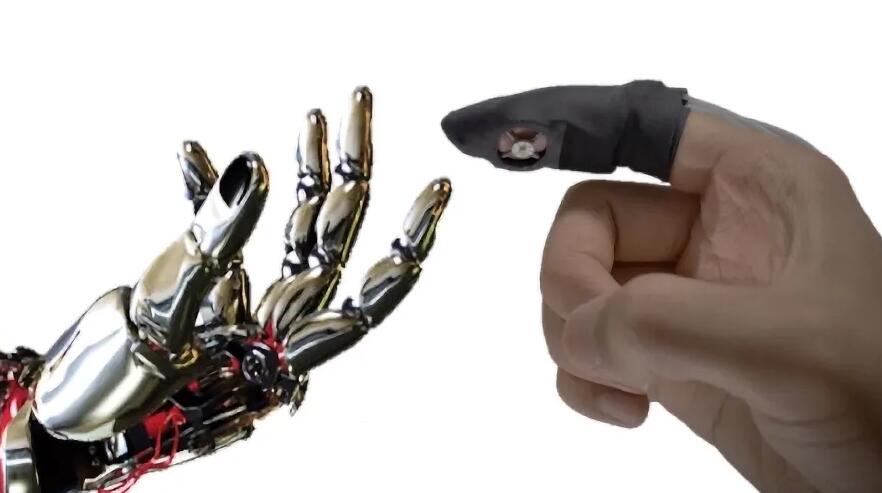Mimicking touch at a distance
新技術(shù)讓人們能在視頻通話中“碰觸”到對方
Video calls are a common occurrence, but have you imagined being able to touch the person on the other end of the line? Scientists are making this a reality.
視頻通話是常事,但你是否想象過能觸碰到屏幕另一邊的人?科學(xué)家正將其變?yōu)楝F(xiàn)實。
Researchers at the University of New South Wales, Australia, have invented a soft skin stretch device (SSD), a haptic device that can recreate the sense of touch. Haptic technology mimics the experience of touch by stimulating localized areas of the skin in ways that are similar to what is felt in the real world, through force, vibration or motion.
澳大利亞新南威爾士大學(xué)的研究人員發(fā)明了一種柔軟的皮膚拉伸裝置,這是種可以重現(xiàn)觸覺的設(shè)備。觸覺技術(shù)通過刺激皮膚的局部區(qū)域,利用力、振動或者運動來模仿觸摸的體驗,達(dá)到類似于真實世界中的感覺。
Vibration is the most common haptic technology today and has been built into many electronic devices, such as one attached to the back of a trackpad in laptops, which simulates a button clicking. However, haptic feedback with vibration becomes less sensitive when used continuously. The existing technology also has great difficulty recreating the sense of touch with objects in virtual environments or located remotely, according to Mai Thanh Thai, lead author of the study.
振動是當(dāng)下最常見的觸覺技術(shù),已配置在了許多電子設(shè)備中,例如,附在筆記本電腦觸控板背面的設(shè)備可以模擬點擊按鈕。但是,當(dāng)設(shè)備被持續(xù)使用時,振動的觸覺反饋敏感度便會下降。該研究的主要作者麥坦泰表示,現(xiàn)有技術(shù)也很難在虛擬環(huán)境或遠(yuǎn)程的物體上重現(xiàn)觸感。

The new technology overcomes issues with existing haptic devices. The research team introduced a novel method to recreate the sense of touch through soft, artificial "muscles".
這項新技術(shù)克服了現(xiàn)有觸覺設(shè)備中存在的問題。研究團(tuán)隊引入了一種新方法,通過柔軟的人造“肌肉”來重現(xiàn)觸覺。
"Our three-way directional skin stretch device, built into the fingertips of the wearable haptic glove we also created, is like wearing a second skin – it's soft, stretchable and mimics the sense of touch – and will enable new forms of haptic communication to enhance everyday activities," said Thanh Nho Do, senior author of the study.
“我們的三向皮膚拉伸設(shè)備內(nèi)置在我們研發(fā)的可穿戴觸覺手套的指尖上,就像戴了柔軟、可拉伸、可模擬觸覺的第二層皮膚,將使觸覺交流的新形式得以實現(xiàn),增強(qiáng)日常活動,”這項研究的項目負(fù)責(zé)人坦仁多表示。
It works like this: Imagine you are at home and you call your friend who is in Australia. You wear a haptic glove with the SSDs and your friend also wears a glove with integrated 3D force sensors. If your friend picks up an object, it will physically press against your friend's fingers. And their glove with 3D force sensors will measure these interactions. The force signals can be sent to your glove so your device will generate the same 3D forces, making you experience the same sense of touch as your friend.
它的工作原理是這樣:想象你正在家中給遠(yuǎn)在澳大利亞的朋友打電話。你戴上配有柔軟皮膚拉伸裝置的觸覺手套,你的朋友也戴著帶有集成3D力傳感器的手套。當(dāng)你的朋友撿起一個物體時,這個物體就會壓在你朋友的手指上,而手套上的3D力傳感器會測量這些相互作用。這些3D力信號可以發(fā)送到你的手套上,因此你的設(shè)備也將產(chǎn)生相同的3D力,讓你能體驗到和你的朋友一樣的觸感。
The haptic devices could be applied in various scenarios, allowing users to feel objects inside a virtual world or at a distance. This could be especially beneficial during such times like the COVID-19 pandemic when people rely on video calls to stay connected with loved ones. Or it could be used in medical practices. Doctors can feel a patient's organ tissues with surgical tools without touching them.
觸覺設(shè)備可以應(yīng)用于多種場景中,讓用戶感受到虛擬世界或遠(yuǎn)距離的物體。疫情期間,人們依靠視頻電話與摯愛的人保持聯(lián)系,在這些時候,觸覺設(shè)備就格外有用。或者也可以用于醫(yī)療實踐中,醫(yī)生無需觸摸,通過手術(shù)工具就能感受到病人的器官組織。











